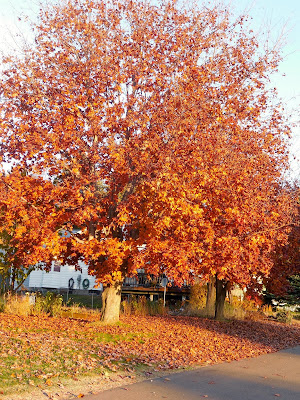 |
| 'CRIMSON KING' NORWAY MAPLEL, FALL FOLIAGE... |
 |
| ....LEAF, WITH FUNGAL LEAF SPOT |
Saturday, 9:00 AM. 38 degrees, wind WSW, light with stronger gusts. the sky is overcast, the humidity is 89%, and things are wet from a bit of rain last night. The barometer is trending down, at 29.66". It looks like we are in for some unsettled weather.
The Norway maple,
Acer platanoides, as its name implies, is of European origin. It is easy to transplant and tolerates many soil conditions and types so it has been much used as a yard and street tree in this country. It is invasive in many urban areas, such as New York's Central Park. It's species name implies that its leaf is similar to that of the plane tree. It can be confused with our native sugar maple, but it is a shorter, more compact tree, without the spectacular fall color of our native maples. It can have a good yellow fall color, but more commonly stays green late and then turns brown. It has many shallow surface roots and it is difficult to grow grass or other plants in close proximity to it. In general it is over-used and has little to recommend it, and it is much more prone to fungal tar spot than other maples.
Some Norway maple seedlings have a tendency to have green-purple leaves, and there have been a number of cultivars with purplish leaves introduced over the years, the oldest being the Schwedler maple. A selection of the Schwedler, the Crimson King maple, was introduced in 1946 and was instantly popular. It has true red-purple leaves all summer long. You can almost identify post-war tract homes, as most have a Crimson King maple in the front yard. They have been called an "exclamation point in the landscape," but unless there is a specific reason to plant it, there are much better tree choices. One of its short comings is that it has no real fall color, but turns from purple to a dingy brown literally overnight, when it becomes rather negatively prominent in the landscape.
Since the Almanac purports to be at least a somewhat scientific journal, I present the following graphic commentary on evolution, compounded from several sources:
 |
| THE EVOLUTION OF HUMANS |
 |
| THE EVOLUTION OF HUMAN HEALTH CARE |















No comments:
Post a Comment